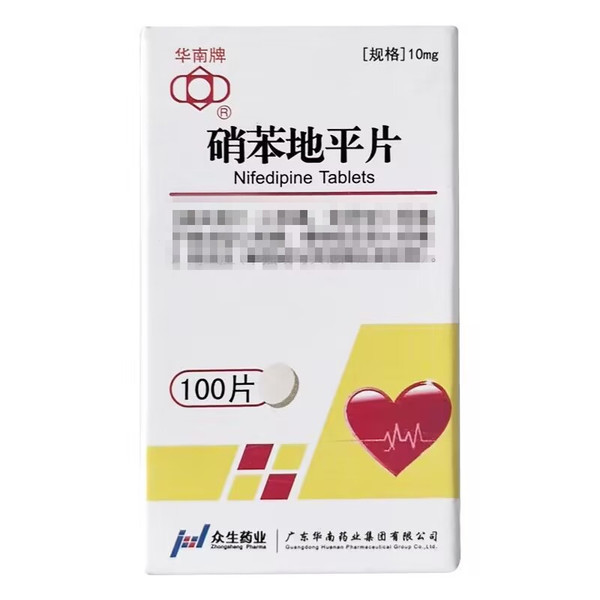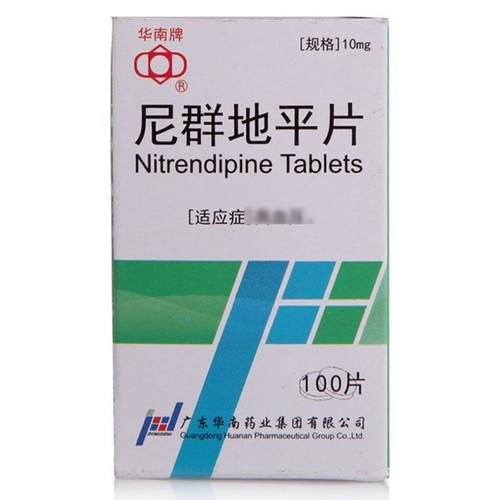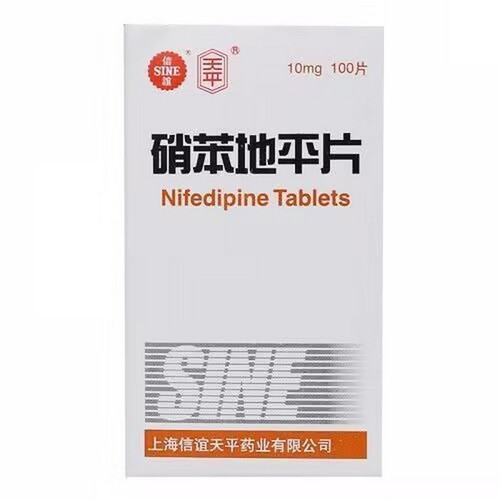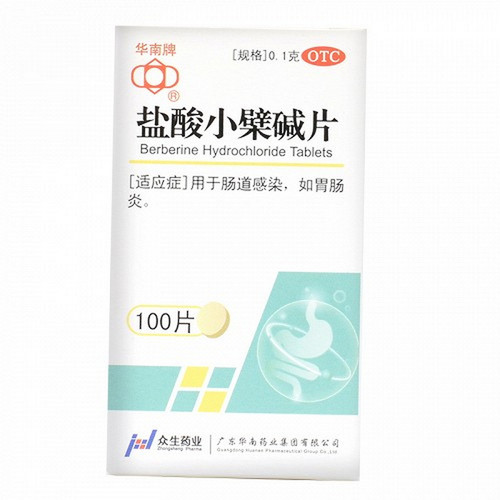Product Overview
[Drug name]
Generic name: Nifedipine tablets
Trade name: Huanan brand Nifedipine tablets 10mg*100 tablets
Pinyin full code: HuaNanPai XiaoBenDiPingPian 10mg*100Pian
[Main ingredients]
The main ingredient of this product is nifedipine, and its chemical name is: 2,6-dimethyl-4 (2-nitrophenyl)-1,,-dihydro-3,5-pyridinedicarboxylic acid dimethyl ester Molecular formula: C17H18N2O6 Molecular weight: 346.34.
[Properties]
This product is a sugar-coated tablet, which is yellow after removing the sugar coating.
[Indications/Main functions]
1. Angina pectoris: variant angina pectoris; unstable angina pectoris; chronic stable angina pectoris. 2. Hypertension (alone or in combination with other antihypertensive drugs).
[Precautions]
1. Hypotension Most patients only experience mild hypotension after taking nifedipine, but some patients experience severe hypotension symptoms. This reaction often occurs during the dose adjustment period or when the dose is increased, especially when used in combination with beta-receptor blockers. Blood pressure should be monitored during this period, especially when other antihypertensive drugs are used in combination. 2. Patients who undergo coronary artery bypass grafting (or other surgeries) under fentanyl anesthesia may experience severe hypotension when taking nifedipine alone or in combination with beta-receptor blockers. If conditions permit, the drug should be discontinued for at least 36 hours. 3. Angina pectoris and/or myocardial infarction Very few patients, especially those with severe coronary artery stenosis, experience reflex irritation and increased heart rate after lowering blood pressure while taking nifedipine or increasing the dose, and the incidence of angina pectoris or myocardial infarction increases. 4. Peripheral edema 10% of patients experience mild to moderate peripheral edema, which is related to arterial dilation. Edema often occurs initially at the end of the lower limbs and can be treated with diuretics. For patients with congestive heart failure, it is necessary to distinguish whether the edema is caused by further deterioration of left ventricular function. 5. Beta-blockers and rebound symptoms Sudden discontinuation of beta-blockers and the start of nifedipine may occasionally aggravate angina pectoris. The dosage of the former must be gradually reduced. 6. Congestive heart failure A small number of patients receiving beta-blockers may develop heart failure after starting to take nifedipine, and patients with severe aortic stenosis are at greater risk. 7. Interference with diagnosis Occasionally, alkalinity may occur when using this product.
[Drug interactions]
People who are allergic to nifedipine are prohibited.
[Drug use in children]
It is not clear yet.
[Drug use in elderly patients]
The half-life of nifedipine is prolonged in the elderly, so pay attention to adjusting the dose when using it.
[Drug use in pregnant women and lactating women]
1. There is no detailed clinical research data. Nifedipine is clinically used for pregnant women with hypertension. 2. Nifedipine can be secreted into breast milk, so lactating women should stop taking the drug or stop breastfeeding.
[Specification]
10mg*100 tablets
[Usage and Dosage]
1. The dose of nifedipine should be gradually adjusted according to the patient's tolerance and control of angina pectoris. Overdose of nifedipine can lead to hypotension. 2. Start with a small dose, usually 10mg/time, 3 times a day; the commonly used maintenance dose is 10-20mg/time, 3 times a day. Some patients with obvious coronary spasm can use 20-30mg/time, 3-4 times a day. The maximum dose should not exceed 120mg/day. If the condition is urgent, 10mg/time can be chewed or taken sublingually, and the drug can be administered again according to the patient's response to the drug. 3. It usually takes 7-14 days to adjust the dose. If the patient has obvious symptoms and the condition is urgent, the dose adjustment period can be shortened.
【Adverse Reactions】
1. Common peripheral edema after taking the drug (peripheral edema is related to the dose, the incidence is 4% when taking 60mg/day, and 12.5% when taking 120mg/day); dizziness; headache; nausea; fatigue and facial flushing (10%). Transient hypotension (5%), most of which do not require discontinuation of the drug (transient hypotension is related to the dose, the incidence is 2% when the dose is less than 60mg/day, and the incidence is 5% when taking 120mg/day). Some patients have angina pectoris, which may be related to the hypotensive reaction. Palpitations; nasal congestion; chest tightness; shortness of breath; constipation; diarrhea; gastrointestinal spasm; abdominal distension; skeletal muscle inflammation; joint stiffness; muscle spasm; mental tension; tremor; nervousness; sleep disorders; blurred vision; imbalance, etc. (2%). Syncope (0.5%), which will no longer occur if the dose is reduced or combined with other anti-anginal drugs. 2. Rare anemia; leukopenia; thrombocytopenia; purpura; allergic hepatitis; gingival hyperplasia; depression; paranoia; instant blindness at peak blood drug concentration; erythromelalgia; antinuclear antibody positive arthritis, etc. (<0.5%). 3. Possible serious adverse reactions: myocardial infarction and congestive heart failure incidence rate 4%; pulmonary edema incidence rate 2%; arrhythmia and conduction block incidence rate less than 0.5% each. 4. Allergic hepatitis, rash, and even exfoliative dermatitis may occur in patients who are allergic to this product.
[Contraindications]
It is contraindicated for patients who are allergic to nifedipine.
[Overdose]
There is no sufficient research data. Existing literature shows that increasing the dose can cause excessive dilation of peripheral blood vessels, leading to or aggravating hypotension. Patients with clinical hypotension caused by drug overdose should be given cardiovascular support treatment in time, including cardiopulmonary monitoring, raising the lower limbs, and paying attention to circulating blood volume and urine volume. If there are no contraindications, vasoconstrictors (norepinephrine) can be used to restore vascular tension and blood pressure. Patients with liver damage have prolonged drug clearance time. Hemodialysis cannot remove nifedipine.
[Pharmacology and Toxicology]
Nifedipine (hereinafter referred to as NF) inhibits the influx of calcium ions into cells by blocking the membrane transport of calcium ions in myocardial and vascular smooth muscle, causing decreased myocardial contractility and vasodilation. Animal experiments have shown that by reducing myocardial contractility and peripheral vascular resistance, myocardial oxygen consumption is reduced; by dilation of coronary vessels and development of collateral circulation, oxygen supply to myocardial ischemic sites is increased; by inhibiting the consumption of high-energy phosphate compounds, the ability to resist hypoxia is enhanced.
[Pharmacokinetics]
After oral administration, it is absorbed rapidly and completely. The blood concentration can be measured 10 minutes after oral administration, and the peak blood concentration is reached about 30 minutes later. The peak time is advanced when the drug is chewed or taken sublingually. There is no significant difference in the bioavailability and half-life of nifedipine between 10 and 30 mg. There is basically no difference in the relative bioavailability of nifedipine tablets when swallowed, chewed or taken sublingually. Nifedipine is highly bound to plasma proteins, about 90%. It takes effect 15 minutes after oral administration, reaches peak effect in 1 to 2 hours, and lasts for 4 to 8 hours; it takes effect 2 to 3 minutes after sublingual administration and reaches peak effect in 20 minutes. The t1/2 is biphasic, with t1/2a of 2.5 to 3 hours and t1/2b of 5 hours. The drug is converted into inactive metabolites in the liver, about 80% of which is excreted through the kidneys and 20% is excreted in the feces. In patients with hepatic and renal insufficiency, the metabolism and excretion rate of nifedipine is reduced.










